Categories
Archives
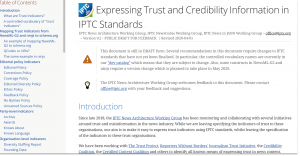
At the IPTC Autumn Meeting in Toronto in 2018, IPTC considered the issues of “trust and credibility” in news media. We looked at the existing initiatives and considered whether IPTC could contribute to the space.
We concluded that some existing efforts were doing great work and that we should not create our own trust and credibility standard. Instead, our resources could best be put towards working with those groups, and aligning IPTC’s standards — particularly our main news standards NewsML-G2 and ninjs — to work well with the outputs of those groups.
Since that time, the IPTC NewsML-G2 Working Group has been collaborating with several initiatives around trust and misinformation in the news industry. We have been working mainly with The Trust Project and the Journalism Trust Initiative from Reporters Without Borders, but have also been in communication with the Credibility Coalition, the Certified Content Coalition and others to identify all known means of expressing trust in news content.
Our aim is to make it easy for users of NewsML-G2 and ninjs to work with these standards to convey the trustworthiness of their content. This should make it easier for news publishers to translate trust information to something that can be read by aggregator platforms and user tools.
In particular, we want to make it as easy as possible for syndicated content to be distributed and published in alignment with trust principles.
A new IPTC Guideline document
To that end, we are publishing a “public draft” of a new IPTC guideline document: Expressing Trust and Credibility Information in IPTC Standards. While not complete, we hope that it helps IPTC members and other users of our standards to understand how they can express trust indicators.
To go along with the draft, we are proposing some changes to existing IPTC standards, including updates to NewsML-G2 and to ninjs, and a new Trust Indicator taxonomy created as part of the IPTC NewsCodes.
New Genres in NewsCodes and changes to NewsML-G2 and ninjs
To accommodate the new work, we will be adding some new entries to the NewsCodes Genre vocabulary. Some genres required for this work such as “Opinion” and “Special Report” were already in the genres vocabulary, but we are proposing to add new genres including “Fact Check” and “Satire“, and some genres to handle sponsored content: Advertiser Supplied, Sponsored and Supported.
We will also be making some small changes to the existing ninjs and NewsML-G2 standards to accommodate some new requirements, such as being able to associate a publisher with another organisation, to indicate membership of The Trust Project, Journalism Trust Initiative or a similar group.
From trusted agency to publisher and then to a user
By following the guidelines, a news agency can add their own trust information to the news items that they distribute. A publisher can then take those trust indicators and convert them to the standard schema.org markup used to convey trust indicators in HTML pages (initially created via a collaboration between schema.org and The Trust Project in 2017).
The schema.org markup can then be read by search engines, platforms such as Facebook, and specialised trust tools such as the NewsGuard browser plugin, so that users can see the trust indicators and decide for themselves whether they can trust a piece of news.
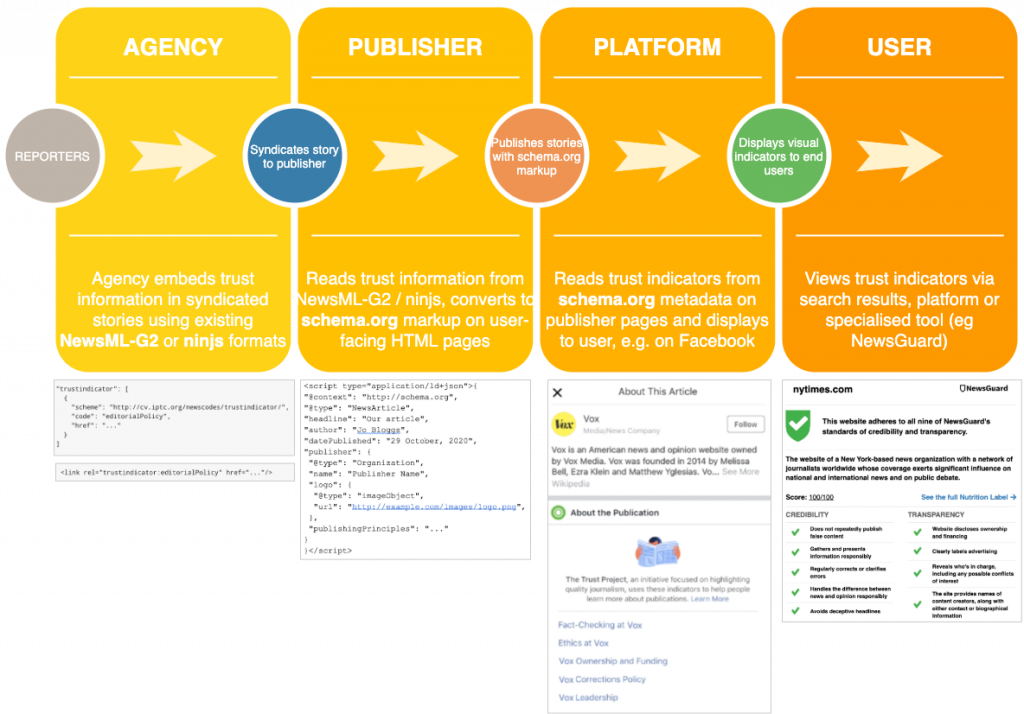
Please give us your feedback
The document will not be final until after those changes have been approved by IPTC members at our next meeting in May.
We have published the draft to ask for feedback from the community about how we could improve our guidance, ask for any trust indicators that we have missed, and to ask for implementation feedback.
Please use the IPTC Contact Us form to send your feedback.
About the Trust Project
The Trust Project is a global network of news organizations working to affirm and amplify journalism’s commitment to transparency, accuracy and inclusion. The project created the Trust Indicators, which are a collaborative, journalism-generated standard for news that helps both regular people and the technology companies’ machines easily assess the authority and integrity of news. The Trust Indicators are based in robust user-centered design research and respond to public needs and wants.
For more information, visit thetrustproject.org.
The Trust Project is funded by Craig Newmark Philanthropies, Democracy Fund, Facebook, Google and the John S. and James L. Knight Foundation.
About the Journalism Trust Initiative
The Journalism Trust Initiative aims at a healthier information space. It is developing indicators for trustworthiness of journalism and thus, promote and reward compliance with professional norms and ethics. JTI is led by Reporters Without Borders (RSF) in partnership with the European Broadcasting Union (EBU), the Global Editors Network (GEN) and Agence France Presse (AFP).
For more, visit https://jti-rsf.org/en/
 In late February we pushed the latest update to Media Topics, IPTC’s main controlled vocabulary for subject classification (also known as a taxonomy).
In late February we pushed the latest update to Media Topics, IPTC’s main controlled vocabulary for subject classification (also known as a taxonomy).
This release includes a translation of NewsCodes into the Danish language.
On behalf of the NewsCodes Working Group and its chair Jennifer Parruci, we would like to say thanks very much to Mette-Lene Østergaard and Mads Petersen from the Danish news agency Ritzau in Denmark for all their work on making the translation.
It’s available from all the usual places:
- The main IPTC Controlled Vocabulary server at cv.iptc.org, which includes both human- and machine-readable versions of all IPTC NewsCodes: http://cv.iptc.org/newscodes/mediatopic/
- HTML browsable view: https://www.iptc.org/std/NewsCodes/mediatopic/treeview/
- Graphical tree view: http://show.newscodes.org/index.html?newscodes=medtop&lang=dk&startTo=Show
- Downloadable Excel version: https://www.iptc.org/std/NewsCodes/IPTC-MediaTopic-NewsCodes.xlsx
The IPTC Media Topic NewsCodes vocabulary is now available in 9 languages: Arabic, British English, Danish, French, German, Portuguese, Brazilian Portuguese, Spanish and Swedish.
We are working with partners on several more language translations coming very soon. If you would like to work with us on contributing a new language translation of IPTC Media Topics or any other IPTC standard, please contact us!
We were very much looking forward to our IPTC 2020 Spring Meeting in Tallinn, Estonia, beautiful city on the Baltic Sea and home city of Brendan Quinn, Managing Director of IPTC. But unfortunately, circumstances mean that we can not hold the meeting in person this time.
Instead we are looking forward to hosting IPTC’s first ever virtual Spring Meeting!
We will be going ahead with the dates that we had planned: Monday May 11 to Wednesday May 13, but rather than having all-day sessions, we will be having sessions from 13.00 to 18.00 UTC on each day.
This meeting will include:
- The usual updates from our working groups including the Photo Metadata Working Group, Video Metadata Working Group, News Architecture Working Group, NewsCodes Working Group, News in JSON Working Group, Sports Content Working Group
- Speakers from IPTC Members such as Reuters, New York Times, Bloomberg and TT on related projects in their newsrooms
- Invited guest speakers from companies related to our standards and key topics
- The special topic focus for this meeting is “robojournalism” and automated media generation
- Because we know how attendees love the networking and interaction sides of our face-to-face meetings, we will have several sessions that aim to let attendees discuss issues with each other and encourage participation in side rooms and through other channels such as our Slack community.
All IPTC Members are invited to attend. For this virtual meeting, there is no cost for IPTC members to attend.
IPTC Member Delegates should look out for an email from Brendan Quinn containing the registration link, or see the event page on the IPTC Members-Only Zone for the registration link.
We are pleased to announce that we have updated our popular Quick Guide to IPTC Photo Metadata and Google Images document to cover the planned updates to Google Image search that we announced last week.
First published in October 2018 after the announcement that Google Images displays image credits based on embedded IPTC Photo Metadata, the Quick Guide has proved very popular as a quick instruction guide showing how photographers and image owners can add the correct metadata fields to their images in a way that ensures image rights information will be displayed in Google search results pages.
Now that Google’s updates to handle “licensable images” have been announced (in beta), we have added new sections to the document so everyone can see all of the IPTC Photo Metadata fields used by Google in one place. We also make clear which fields will be used by Google straight away and which fields will only be displayed after the public launch of the new feature.
All comments and suggestions to the document are welcome. Please post to the public iptc-photometadata discussion list or use the IPTC contact form if you would like to get in touch.
We are excited to announce that the result of our latest collaboration with Google has been launched in a beta phase: Licensable Images.
This feature, that Google is exploring with this beta, will enable image owners not only to receive credit for their work but also to find ways to raise people’s awareness of licensing requirements for content found via Google Images.
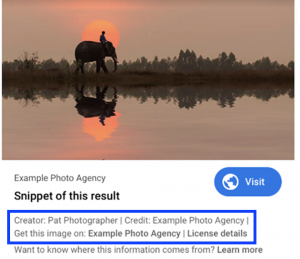
By embedding IPTC Photo Metadata fields into their images (or using schema.org markup), Google will place a badge on licensable images in search results pages.
Under the image preview, Google will show embedded rights metadata (creator, copyright and credit fields). These have been displayed since IPTC’s collaboration with Google in 2018, but will now be given more prominence.
Along with the rights metadata, Google will now show links to the image’s usage licence and also a link to “Get this image”.
See the image for a mockup of how it might look.
By embedding IPTC Photo Metadata into your images, these links will be shown for images on your own website and also when your customers publish images on their sites.
Along with the photo industry organisation CEPIC, IPTC has been working with Google on this project since the IPTC Photo Metadata Conference at CEPIC Congress in June 2019.
The user-facing side of the feature is planned to launch in the next few months. Google has released some developer documentation to encourage image owners to get ready for the launch.
Learn how to make licensable images work for your image collections
For IPTC members, we will be running a webinar today, Thursday 20 February at 15:00 GMT.
The webinar will explain how the licensable images feature works and what image owners can do to get ready for the launch.
The speakers will be Michael Steidl, Lead of the IPTC Photo Metadata Working Group, and Brendan Quinn, Managing Director of IPTC.
Please check your email for the announcement and information on how to join.
For non-members, we will be publishing a page on this site on Friday 21 February that will explain how to take advantage of the feature.
UPDATE: We have now updated our Quick Guide to IPTC Photo Metadata and Google Images to include information on how to embed rights and licensing metadata in your images.
We’re very pleased to see this launch. We look forward to seeing how our members will use this feature to draw more attention to the importance of image rights and licensing.
To support the work of IPTC in this and other areas, please consider joining IPTC.
Following many change requests submitted by news organisations all over the world, the IPTC News in JSON Working Group is happy to announce the 1.2 version of its standard ninjs.
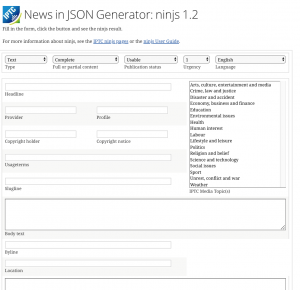
The JSON Schema of the new version can be accessed at https://www.iptc.org/std/ninjs/.
We also created a ninjs User Guide that will enable new and existing users to understand how to put ninjs to use at their organisation.
Version 1.2 is backwards-compatible with version 1.0 and 1.1 and makes no breaking changes.
It includes the following new properties and structures:
- The
firstcreatedproperty goes along with theversioncreatedproperty to specify the date/time when the first version of a news item was published. - The
charcountandwordcountproperties allow the publisher to specify the total character count and word count of a news item (excluding figure captions and metadata). - The
slugline, property allows the publisher to specify a “slug”, a human-readable identifier for the item. (note that no conditions are placed on the usage of this property, usage is up to each publisher). - The
ednote, property allows publishers to specify instructions to editors. - The
infosourcestructure can specify one or many information sources for the news item. It is a metadata structure that can handle literal strings or values from a controlled vocabulary. - The
titleproperty handles “A short natural-language name for the item.”
Also the following sub-properties were added:
- The value
componentwas added to the allowed values fortypeto specify parts of a larger news item. - The description of the
renditionsproperty was changed to allow for any type of rendition, not just images, and new sub-propertiesdurationandformatwere added to enable audio and video renditions (for example, an audio version of a text story).
We have also included a test and validation suite so new versions of the JSON Schema can automatically be checked for compliance and backwards compatibility.
ninjs 1.2 is now included in the SchemaStore.org JSON Schema repository, to aid with editing and validation of ninjs 1.2 files in a range of popular code editors such as Visual Studio Code and Visual Studio 2013+, IntelliJ IDEA, PyCharm and PHPStorm.
For more information, please see:
- The ninjs GitHub repository
- ninjs example documents
- The ninjs User Guide
- The ninjs 1.2 JSON Schema specification
- A new interactive tool for creating example ninjs documents – the ninjs Generator
If you have any questions or comments, please contact the News in JSON Working Group via the public ninjs discussion group, or contact IPTC via the Contact Us form.
At the IPTC Meeting in Ljubljana Slovenia in Autumn 2019, we welcomed several new faces to IPTC working groups, the Board and voted in a new Chair!
With so many changes happening at the same time, we thought it would be good to introduce the new faces here so members and others can get to know them all better. (All IPTC working group leads, committee leads and directors can be found on the Work Structure and About IPTC pages.)
Video Metadata Working Group lead: Pam Fisher
 Pam Fisher is with IPTC as an Individual Member, and we are very happy to have her lead the Video Metadata Working Group, looking at further development and promotion of Video Metadata Hub and video technology in general.
Pam Fisher is with IPTC as an Individual Member, and we are very happy to have her lead the Video Metadata Working Group, looking at further development and promotion of Video Metadata Hub and video technology in general.
Pam has a long history with media and video technology, working with organisations such as BAFTA, Moving Image Research and Communication Arts.
News in JSON Working Group lead: Johan Lindgren
 Johan has led the Sports Content Working Group since 2016 but with the current resurgence of interest in JSON news formats, decided to move to lead the News in JSON Working Group.
Johan has led the Sports Content Working Group since 2016 but with the current resurgence of interest in JSON news formats, decided to move to lead the News in JSON Working Group.
Representing TT Nyhetsbyrån, Sweden’s national news agency, Johan has been active with IPTC for over 20 years, a regular meeting attendee and has been on the IPTC Board since 2016.
Sports Content Working Group lead: Paul Kelly
With Johan taking the reins of the News in JSON group, Paul is stepping (back) up to lead the Sports Content working group. Paul is also a long-time IPTC member, having been lead of the Sports Content working group from 2005 through to 2016 while he represented XML Team Solutions. Now an independent consultant, Paul has retained his ties with IPTC as an Individual Member and we are very happy to see him leading the Sports Content working group once more.
Chair of the IPTC PR Committee: Linda Burman
Linda has been an Individual Member since 2015, and has actively participated in several working groups including the Photo Metadata and Video Metadata Working Groups. We look forward to reviving the IPTC Public Relations Committee under Linda, looking at how to spread the word about the benefits of IPTC to the media industry and beyond.
New Board member: Jennifer Parrucci
 Jennifer has been an IPTC delegate for the New York Times since 2015, and lead of the News Codes Working Group since 2016. Jennifer has done a great job in leading the News Codes Working Group to maintain and develop the News Codes taxonomies, particularly the Media Topics subject vocabulary. We are looking forward to Jennifer’s contributions to the future of IPTC as part of the Board.
Jennifer has been an IPTC delegate for the New York Times since 2015, and lead of the News Codes Working Group since 2016. Jennifer has done a great job in leading the News Codes Working Group to maintain and develop the News Codes taxonomies, particularly the Media Topics subject vocabulary. We are looking forward to Jennifer’s contributions to the future of IPTC as part of the Board.
New Board member: Paul Harman
 Paul Harman has been an IPTC member for over 20 years, first with Press Association and now with Bloomberg LP. Paul worked on NewsML 1, NewsML-G2 and News in JSON (ninjs) while he was an architect with Press Association and carried it on at Bloomberg, his employer since 2014.
Paul Harman has been an IPTC member for over 20 years, first with Press Association and now with Bloomberg LP. Paul worked on NewsML 1, NewsML-G2 and News in JSON (ninjs) while he was an architect with Press Association and carried it on at Bloomberg, his employer since 2014.
Paul is an active member of the News Architecture, News in JSON and News Codes working groups, and we’re very happy to welcome him to the IPTC Board of Directors.
New Chair: Robert Schmidt-Nia
 Robert has been with IPTC since 2007 representing dpa, the German national news agency, where he has been Managing Director of subsidiary dpa mediatechnology since 2013.
Robert has been with IPTC since 2007 representing dpa, the German national news agency, where he has been Managing Director of subsidiary dpa mediatechnology since 2013.
Robert joined the board of IPTC in 2013 and has been a very active participant, so we were very happy to see him voted by the membership to become Chair of the IPTC Board of Directors.
Welcome to everyone and thanks for sharing your time, knowledge and expertise. Your fellow members appreciate it!
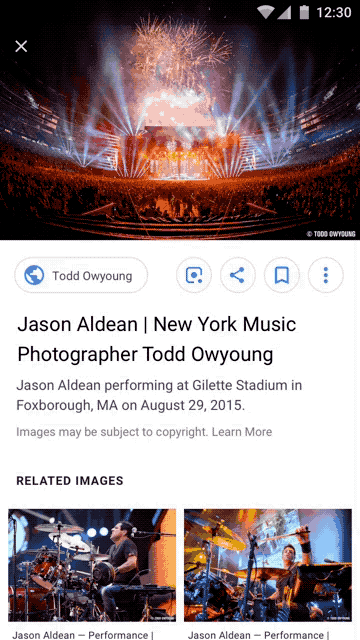
Rights-related photo metadata can now be accessed directly in Google Image Search results, thanks to a joint effort by IPTC, Google and CEPIC, the Council of European Professional Informatics Societies.
Google, the IPTC and CEPIC worked together closely to determine the best way to incorporate metadata in Google search results of images to identify an image’s author and rights holder.
When users see an image in a Google search result, they can click the “image credits” link to see the image’s creator and credit information, read from IPTC embedded metadata. Over the coming weeks, copyright notice metadata will also be added.
“Embedded IPTC photo metadata has an essential role for photos posted on a website,” said Michael Steidl, lead of IPTC’s Photo Metadata and Video Metadata Working Groups. “These fields easily show people searching for images who its creator and copyright owner is. We encourage all parties who post images on the web to fill in these IPTC fields.”
Photo metadata is vital to guarding images’ licensing and copyright information online, and essential for managing digital assets.
The IPTC Photo Metadata Standard is the most widely used specification for describing photos, due to its universal acceptance among news outlets, photographers and photo agencies, libraries, museums and other related organisations. Most major photo software vendors support IPTC’s Photo Metadata Standard.
In a recent blog post, Google Image’s product manager Ashutosh Agarwal said this change will help promote “a healthy visual content ecosystem.”
Brendan Quinn, Managing Director of IPTC, said “we are looking forward to continuing our work with Google on IPTC Photo Metadata and other areas. We have a ton of ideas on how we can work together and are looking forward to using our standards to make the web more searchable and more accountable.”
IPTC has prepared a Quick Guide to IPTC Photo Metadata and Google Image Search to help users, developers and site administrators understand what they need to do to ensure that their metadata is shown in Google Image Search results.
For more detailed help with questions and implementation of IPTC’s Photo Metadata standard, see our IPTC Metadata User Guide.
Publishers, broadcasters, news and photo agencies and tool vendors are encouraged to join IPTC to work with us and Google on future projects. See the Participate pages for information on joining and working with IPTC.
“For years, the professional photography community has relied on IPTC metadata as the cornerstone of copyright protection,” said Andrew Fingerman, CEO of PhotoShelter, a provider of digital asset management tools for photographers and brands. “As assets are change hands, pass through organisations, and are published with greater frequency, IPTC metadata provides the basis for identifying the creator and rights owner. This major step by Google and IPTC will help everyone discover, identify, and trace copyright. We applaud this collaboration!”
For more information, contact us via this web site or email Managing Director Brendan Quinn on mdirector@iptc.org.
For more information:
IPTC Photo Metadata Standard – Guidelines and Support
Join the public IPTC Photo Metadata groups.io Group
Join IPTC: Membership Information
Twitter: @IPTC
LinkedIn: IPTC
Google Blog: Images Rights Metadata In Google Images
The International Press Telecommunications Council is happy to announce that RightsML, IPTC’s Rights Expression Language for the media industry, has been updated to version 2.0.
RightsML allows publishers and media owners to express rights permissions and obligations based on geographic, time-based, and monetary restrictions.
This version contains major updates: it is now based on W3C’s Open Digital Rights Language (ODRL) version 2.2 which became a W3C recommendation in February 2018.
ODRL allows content providers to “express permission, prohibition, and obligation statements to be associated to content.” RightsML extends on that base to provide standard expressions for geographic and time-based constraints, on a requirement to pay fixed amounts of money for use of the content,
An example RightsML model which expresses that EPA (Example Press Agency) grants its partners geographic rights to distribute a content item in Germany is as follows:
Policy: type: "http://www.w3.org/ns/odrl/2/Set" uid: "http://example.com/RightsML/policy/idGeog1" profile: "https://iptc.org/std/RightsML/odrl-profile/" permission: - target: "urn:newsml:example.com:20120101:180106-999-000013" assigner: "http://example.com/cv/party/epa" assignee: type: "http://www.w3.org/ns/odrl/2/PartyCollection" uid: "http://example.com/cv/partygroup/epapartners" action: "http://www.w3.org/ns/odrl/2/distribute" constraint: - leftOperand: "http://www.w3.org/ns/odrl/2/spatial" operator: "http://www.w3.org/ns/odrl/2/eq" rightOperand: "http://cvx.iptc.org/iso3166-1a3/DEU"
This content model can also be expressed in XML or JSON. See the RightsML Simple geographic Example for more information.
More examples are on the RightsML 2.0 Examples page on the IPTC developer site.
IPTC has also created tools to help implementors understand and implement RightsML 2.0, including a generic guideline flow for evaluating ODRL documents and a RightsML policy builder tool.
For more details and help on implementing RightsML within your organisation, please join the IPTC RightsML mailing list. Membership of the group is open to the public. For discussion on developing further versions of the standard, please use the IPTC RightsML-dev list, open to all IPTC members.
As announced in late April, Brendan Quinn is succeeding Michael Steidl in the position of Managing Director of IPTC in June 2018.
This change is happening right now: Brendan has taken over the responsibilities and actions of the Managing Director and Michael is available for giving advice to Brendan until the end of June.
From now on Brendan should be contacted as Managing Director. He uses the same email address that Michael used before: mdirector@iptc.org.
Note from Brendan
I’m really looking forward to working with all IPTC’s members and friends, and hope that I can make a real difference to the future of the news and media industry through my work with IPTC.
I aim to speak with as many of you as possible over the next weeks and months to find out what you as members like and don’t like about what IPTC is doing, but in the meantime, please feel free to email me via mdirector@iptc.org or find me on the members-only Slack group, and I would be happy to say hello and to hear your thoughts.
Michael and I sat down to hand over the role in early June so I now have a sense of the task before me, and I hope that I can follow up on his work but also bring a fresh energy to the organisation.
I would especially like to thank Michael for all his efforts over the last 15 years in making IPTC what it is today.
Best regards, and see you in Toronto in October if not before!
Brendan.
Note from Michael
It was a great experience to help Brendan diving into the IPTC universe with all its members and workstreams plus many contacts in the media industry. I wish you, Brendan, all the best for a great future at this organisation.
Dear all who showed interest in IPTC, it was a pleasure getting in touch with you and I hope I was able to respond in a way helping you to solve problems.
I was invited to continue as Lead of the Photo Metadata and Video Metadata Working Groups and I’m happy to take on responsibility for these workstreams. If you want to contact me from now on please use my own email address mwsteidl@newsit.biz
Best,
Michael